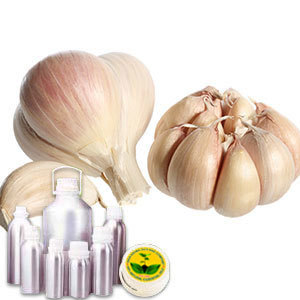| Botonical Name | Allium Sativum |
| CAS # | 8000-78-0 |
| Country of Origin | Mexico |
| Color & Odor | Yellow to orange red liquid @22C with Strong Garlic odor |
| Solubility | Insoluble in water, soluble in alcohol and oils |
| F.E.M.A | 2503 |
| Specific Gravity | 1.0400 to 1.1180 @ 25°C |
| Optical Rotation | -2° to +2° |
| Refractive Index | 1.559 - 1.579 @ 25°C |
| Flash Point | 47°C |
| Major Constituents | diallyltrisulphide (29.7%), diallyltetrasulphide (4.4%), diallyldisulphide (3.2%), diallylsulphide (2.5%) and methylallyltrisulphide (2.1%) were identified. |
| Plant Part Used | Bulb |
| Extraction Method | Steam distillation |
DESCRIPTION:
Widely used for cooking and treatment purpose, garlic belongs to the family of Alliaceae onion. Notable for its bulb shaped appearance this herb is basically popularly used part of 12 to 16 inches long plant. Depending on variety, every bulb of garlic contains five to fifteen cloves ( approx).
CONSTITUENTS:
Garlic oil is enriched with beneficial compounds like methylallyltrisulphide, Dimethyl (6%) mono- to hexasulfides, DAS (57%), diallylsulphide, diallyltetrasulphide, Allylmethyl (37%), diallyldisulphide and diallyltrisulphide.
AROMATIC SUMMARY / NOTE / STRENGTH OF AROMA:
The top note smell of this essential oil has long lasting and powerful scent of garlic which is not suitable for formulating perfumes or any other aromatic substances.
BLENDS WITH:
Garlic oil can be mixed with sour cream and cheese with cream like texture to prepare vegetable dips.
COMMON NAMES:
Garlic essential oil is also referred as Allium sativum oil.
USES:
Garlic Oil is suggested to cure flu, bronchitis, cold and bacterial infections for its anti hypertensive, antiseptic and antibacterial properties.



































